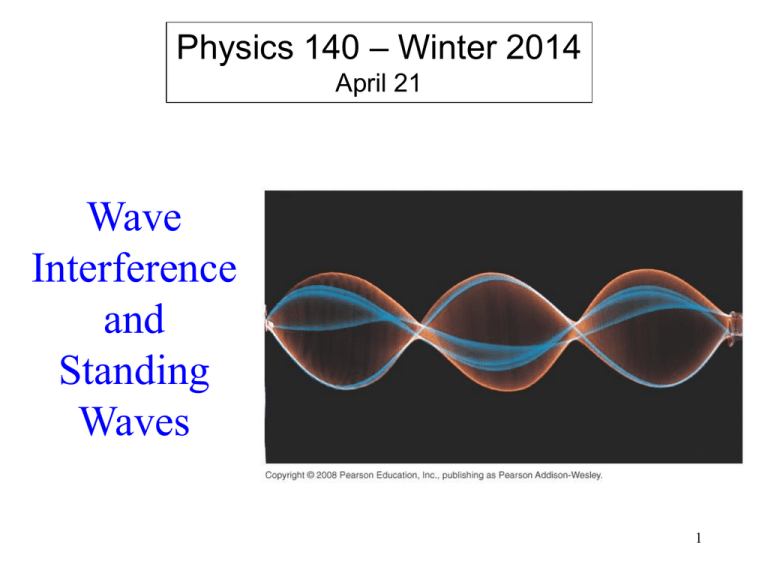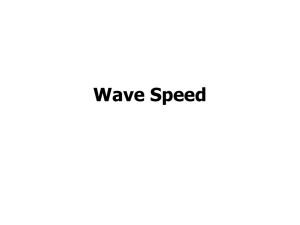Standing Wave - tenaya.physics.lsa.umich.edu
advertisement

Physics 140 – Winter 2014 April 21 Wave Interference and Standing Waves 1 Questions concerning today’s youtube video? 3 Reflections A sinusoidal wave is generated by shaking one end (x = L) of a fixed string so that the following traveling wave is created: y1 (x,t) Acos(kx t) What is a possible equation for a wave y2(x, t) reflected from the other (fixed) end of the string (x = 0)? A) A cos(kx t) C) A cos(kx t) E) Asin(kx t) String fixed at x = 0 B) A cos(kx t) D) Asin(kx t) y(0, t) = 0 for all t Need rightward-moving wave and y2 (0,t) y1 (0,t) y2 (0,t) Acos(t) Standing Wave – part 1 • A string is clamped at both ends and then plucked so that it vibrates in a standing mode between two extreme positions (a) and (c). Let upward motion correspond to positive velocities. When the string is in position (b), the instantaneous velocity of points along the string is... a A. B. C. D. zero everywhere negative everywhere positive everywhere depends on position b c node: never moves. Standing Wave – part 2 • A string is clamped at both ends and then plucked so that it vibrates in a standing mode between two extreme positions (a) and (c). Let upward motion correspond to positive velocities. When the string is in position (c), the instantaneous velocity of points along the string is... a A. B. C. D. zero everywhere negative everywhere positive everywhere depends on position b c Plucking a string • A string on a string instrument plays an A (440 Hz) when plucked. If you put your finger down in the middle of the string, and then pluck, you are mostly likely to hear: A. B. C. D. E. Note A an octave higher (880 Hz) Note A an octave lower (220 Hz) Same note/tone Another note [different from (A), (B), and (C)] Nothing f = 1/T = v/λ Reducing λ by 2 increases f by 2 Two Piano Strings • Two piano strings have the same tension, are made from the same material, and have the same length, but string B is thicker (has larger diameter) than string A. How will the pitch from string B compare to that of string A? A. B. C. D. Lower than that of string A Higher than that of string A The same as that of string A Not enough information 1 Ft f1 2L μ is greater for B Lower f A driven string oscillating between two posts (fixed boundaries) exhibits a standing wave pattern with three nodes between the posts. If the tension in the string is increased by a factor 4 with all else held constant, including driving frequency, how many nodes will there be between the posts? 1. 2. 3. 4. 5. Since v F One Three Five Seven Nine Before: After: , increasing F by 4 increases v f by 2 increased by 2 2 antinodes 1 node 9 A Guitar String A nylon guitar string of mass 6.48 g and length 0.9 m is supposed to resonate at the fundamental frequency of 80 Hz. What tension should be applied to the string? A. B. C. D. E. 59 N 83 N 149 N 317 N 550 N v v 1 f1 2L 2L Ft m where L Ft 2Lf1 4 f Lm 2 2 1 Ft 4(80.0 Hz) (0.9 m)(0.00648 kg) = 149 N 2 Resonant rod A metal rod can be excited to resonate in its audible fundamental mode by rubbing it at the right frequency. What is the nature of this normal mode? A) Transverse B) Longitudinal C) Torsional The vibration is a sound wave (longitudinal) traveling back and 11 forth along the rod y(x,t) Asin(kx)sin( t) Varying amplitude A string with both ends held fixed is vibrating in its third harmonic. The waves have a speed of 192 m/s and a frequency of 240. Hz. The amplitude of the standing wave at an antinode is 0.400 cm. What is the amplitude at a point on the string 10.0 cm from its left end? 1) 2) 3) 4) 5) 0.141 cm 0.212 cm 0.283 cm 0.354 cm 0.425 cm k 2 f 240. Hz 2 2 7.85 m 1 v 192 m/s Amplitude at x is Asin(kx) (0.400 cm)sin[(7.85 m1 )(0.100 m) = 0.283 cm 12 Elapsed time A string with both ends held fixed is vibrating in its third harmonic. The waves have a speed of 192 m/s and a frequency of 240 Hz. The amplitude of the standing wave at an antinode is 0.400 cm. How much time does it take the string to go from its largest upward displacement at x = 10.0 cm to its largest downward displacement? 1) 1.08 × 10-3 s 2) 1.48 × 10-3 s 3) 2.08 × 10-3 s 4) 2.48 × 10-3 s 5) 3.08 × 10-3 s Need half the period: 1 1 1 T 2.08 10 3 s 2 2 f 2(240. Hz) 13 Acceleration Amp(10 cm) = 0.283 cm A string with both ends held fixed is vibrating in its third harmonic. The waves have a speed of 192 m/s and a frequency of 240 Hz. The amplitude of the standing wave at an antinode is 0.400 cm. What is the maximum transverse acceleration of the string at x = 10.0 cm? 1) 2) 3) 4) 5) 6.43 × 10−2 m/s2 6.43 × 10−1 m/s2 6.43 × 10+1 m/s2 6.43 × 10+2 m/s2 6.43 × 10+3 m/s2 Each point on the string behaves as a S.H.O.: Maximum acceleration amax (x) 2 A(x) amax (10.0 cm) = [2 (240.0 Hz)]2 (0.283 cm) = 6.43 10 3 m/s2 14 Changing frequency kg kg W 1000 3 and A 2700 3 m m When a massive aluminum sculpture is hung from a steel wire, the fundamental frequency for transverse standing waves on the wire is 250.0 Hz. The sculpture (but not the wire) is then completely submerged in water. What is the new fundamental frequency? 1) 2) 3) 4) 5) Submerged: Ft mg 198 Hz 224 Hz 250 Hz 279 Hz 302 Hz 1 Ft f1 2L f1submerged original f1 Ft Fbuoy Ft submerged Ft original Ft mg Fbuoy AlumVg WaterVg Alum Water 2700 1000 0.793 Alum 2700 mg 15







